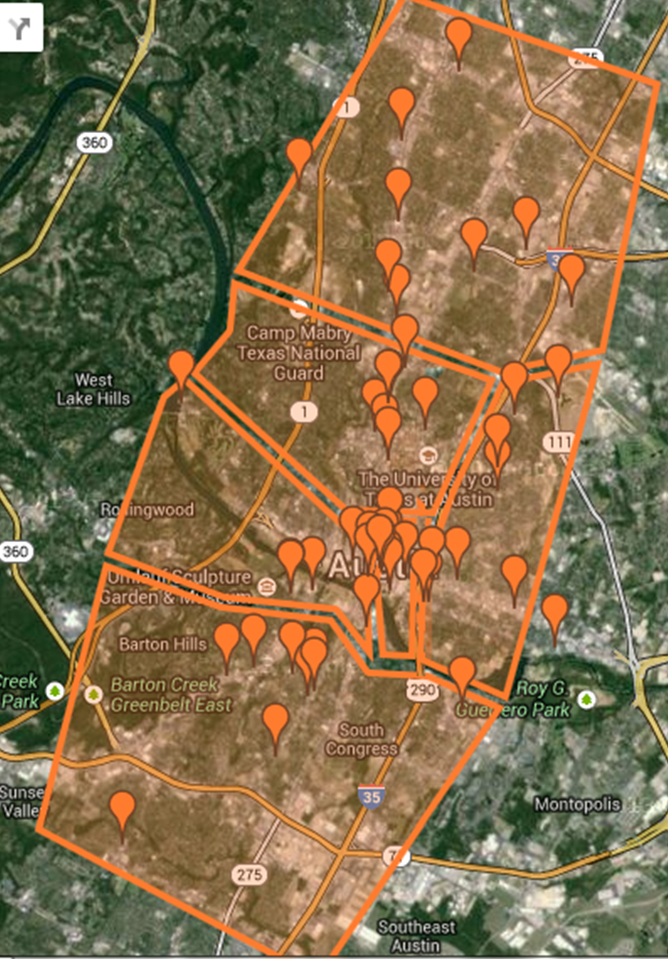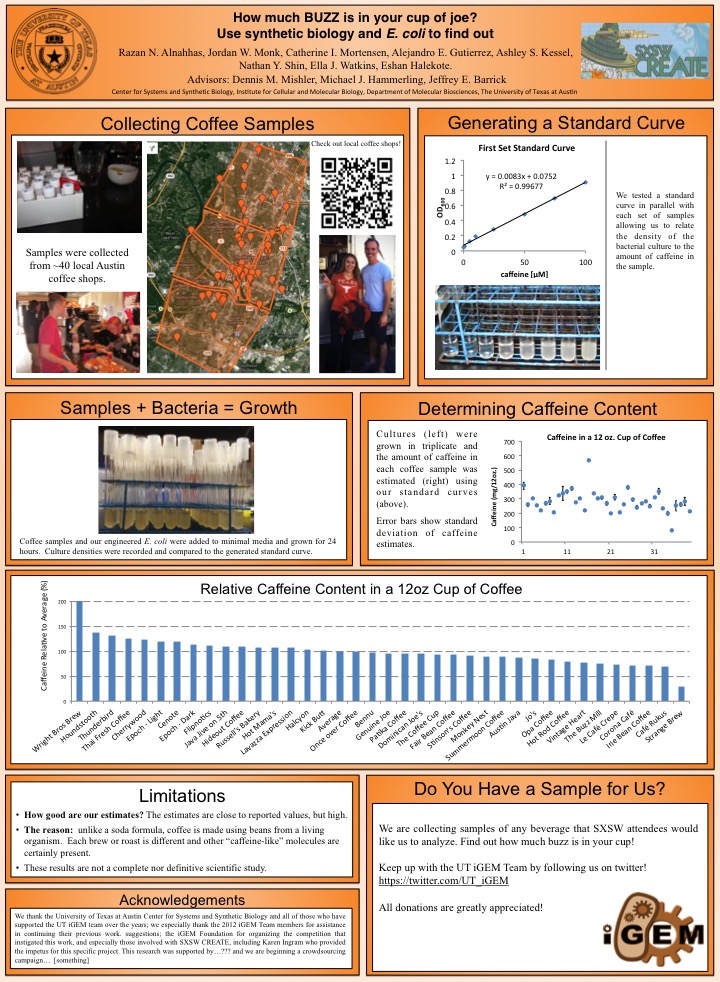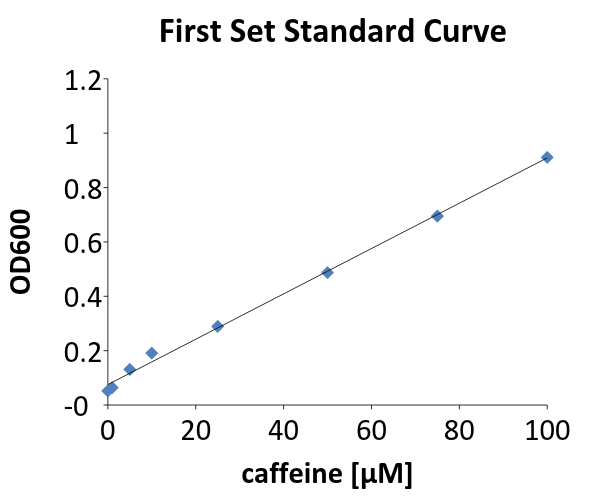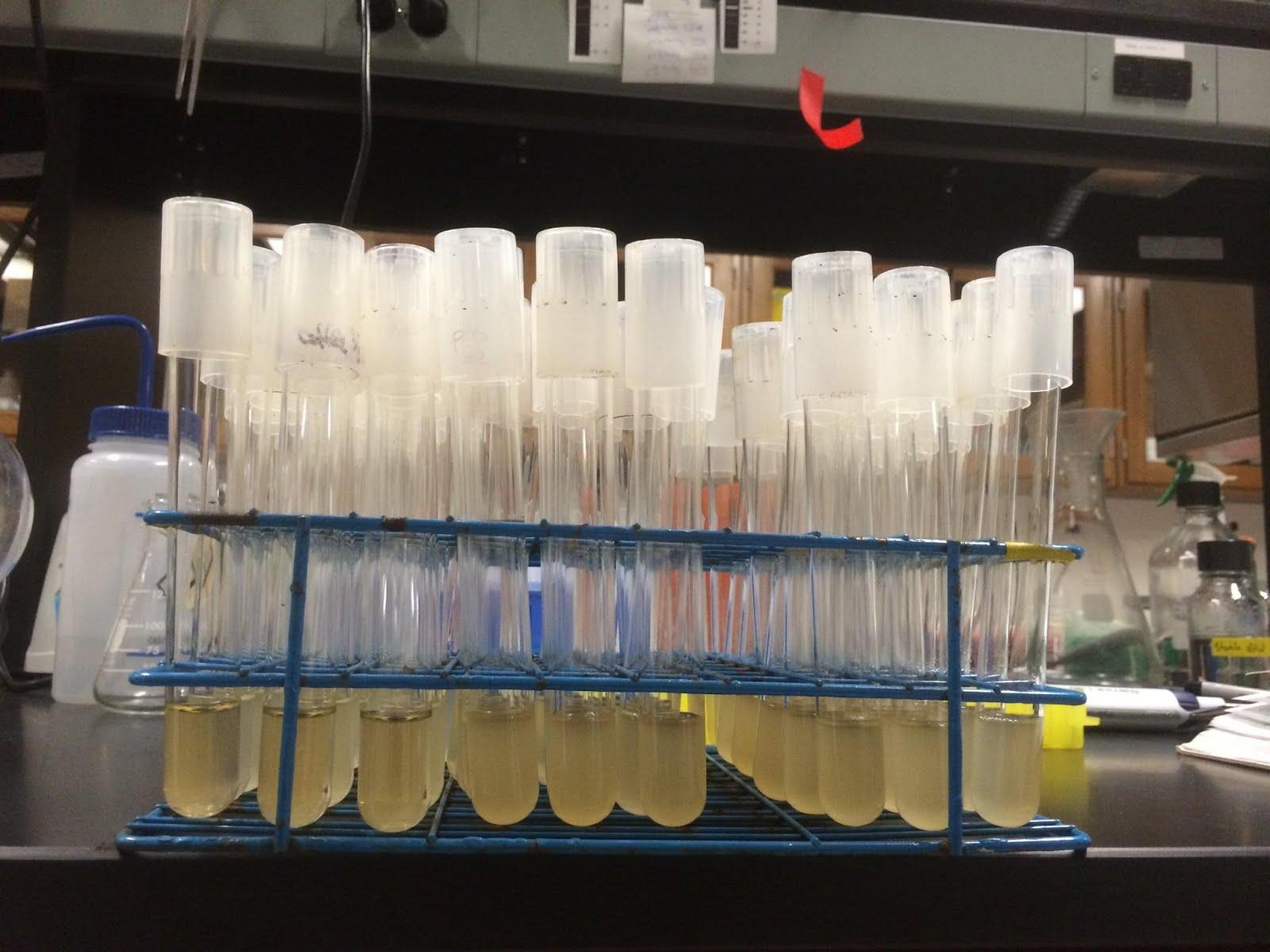Team:Austin Texas/human practices
From 2014.igem.org
Jordanmonk (Talk | contribs) |
Jordanmonk (Talk | contribs) (→Caffeinated Coli) |
||
| Line 60: | Line 60: | ||
==Caffeinated Coli== | ==Caffeinated Coli== | ||
| - | [[file:UT_Austin_Coffee_shops_map.png|200px|thumb|right| Figure 2. [https://www.google.com/maps/d/viewer?mid=zlUDhks6KHxI.ketDvlvg6zis Map of coffee shops we visited.]]]In 2014, the UT Austin iGEM team reached out to the community by going to dozens of Austin coffee shops, collecting samples of their house coffee. The samples were taken back to lab, and using a strain of E. coli previously developed by the 2012 UT Austin iGEM, we employed these E. coli to assess how much caffeine was present in each cup of coffee. | + | [[file:UT_Austin_Coffee_shops_map.png|200px|thumb|right| Figure 2. [https://www.google.com/maps/d/viewer?mid=zlUDhks6KHxI.ketDvlvg6zis Map of coffee shops we visited.]]]In 2014, the UT Austin iGEM team reached out to the community by going to dozens of Austin coffee shops, collecting samples of their house coffee. The samples were taken back to lab, and using a strain of ''E. coli'' previously developed by the 2012 UT Austin iGEM, we employed these ''E. coli'' to assess how much caffeine was present in each cup of coffee. |
| Line 83: | Line 83: | ||
| - | A couple of weeks later, we presented this data set at the 2014 South by Southwest (SXSW) festival as part of the SXSW Create section, which focuses on maker/hacker/ | + | A couple of weeks later, we presented this data set at the 2014 South by Southwest (SXSW) festival as part of the SXSW Create section, which focuses on the maker/hacker/DIY culture. As part of this outreach, we explained our project and synthetic biology to a wide range of people (Figure 3). Many people who came by had little to no background in science or technology, and even most of the ones who did had not heard about synthetic biology. By discussing our experiments with bacteria and coffee, an interesting and easy to understand application, we were able to explain what synthetic biology is and how it can be used in a beneficial way. Occasionally, these conversations would branch out into wider topics of science and technology. |
| - | This included a follow up conversation with one of the owners of Wright Bros. Brew & Brew, whose coffee seemed to have significantly more caffeine. | + | [[file:sxswposter.jpg|thumb|300px|left| Figure 3. Poster presented at SXSW]] |
| + | |||
| + | This included a follow up conversation with one of the owners of Wright Bros. Brew & Brew, whose coffee seemed to have significantly more caffeine. The owners concluded, after discussing our project and the coffee brewing process, that the specific pot of coffee was probably just not fully drained, i.e. there was less water in the batch than normal, resulting in a higher caffeine/volume content. However, similar conversations were had between the entire team and the various coffee shops and baristas during the collection and presentation processes. | ||
| Line 91: | Line 93: | ||
[[file:UT_Austin_caffeine_growth_standard_curve.png|200px|thumb|right| Standard growth curve of knockout strain grown with different amounts of caffeine.]] | [[file:UT_Austin_caffeine_growth_standard_curve.png|200px|thumb|right| Standard growth curve of knockout strain grown with different amounts of caffeine.]] | ||
| + | [[file:UT_Austin_E._coli_coffee_cultures.jpg|300px|thumb|right| Cultures of knockout strain grown with collected coffee samples.]] | ||
| + | |||
| + | The ''E. coli'' we used are a synthetic strain, previously made by the [https://2012.igem.org/Team:Austin_Texas 2012 UT Austin iGEM team]. This strain lacks [...its normal guanine synthesis pathway], but contains a plasmid with a set of genes that enables the organism to synthesize guanine from xanthine and many of its derivatives, including caffeine. Without caffeine (or other xanthines), the strain cannot not grow. When caffeine is added, the strain grows normally until the caffeine is completely metabolized, at which point the cells can no longer synthesize guanine, and cease to grow. Thus, by looking at the relative growth of the strain with different samples of coffee and comparing it to a standard curve of growth in solutions with known amounts of caffeine, we could somewhat accurately measure the amount of caffeine in the coffee. | ||
| - | |||
| - | |||
Revision as of 05:12, 12 October 2014
|
 "
"





